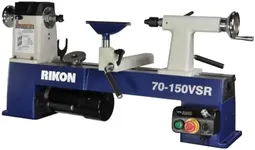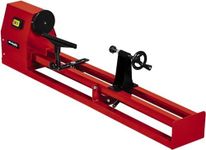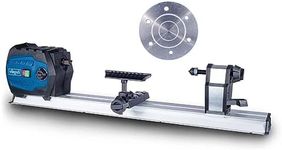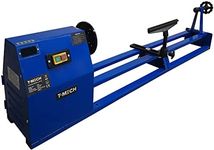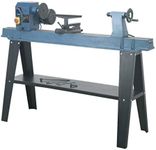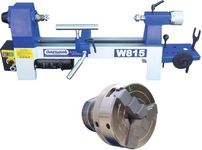Buying Guide for the Best Wood Lathes
Choosing the right wood lathe can significantly impact the quality and ease of your woodworking projects. A wood lathe is a machine used to shape wooden pieces by rotating them against various cutting tools. When selecting a wood lathe, it's important to consider several key specifications to ensure it meets your needs and skill level. Understanding these specifications will help you make an informed decision and find the best fit for your woodworking projects.Swing Over BedThe swing over bed is the maximum diameter of the workpiece that can be turned on the lathe. This spec is important because it determines the size of the projects you can work on. Lathes with a swing over bed of 10-12 inches are suitable for small projects like pens and bowls, while those with 14-16 inches are good for medium-sized projects. Larger lathes with a swing over bed of 18 inches or more are ideal for big projects like furniture legs. Choose a swing over bed that matches the size of the projects you plan to undertake.
Distance Between CentersThe distance between centers is the maximum length of the workpiece that can be mounted on the lathe. This spec is crucial for determining the length of the projects you can work on. A distance between centers of 12-20 inches is typically sufficient for small to medium projects, while 30 inches or more is needed for larger projects like table legs or baseball bats. Consider the typical length of the pieces you plan to turn when selecting a lathe with the appropriate distance between centers.
Motor PowerMotor power, measured in horsepower (HP), affects the lathe's ability to handle different types of wood and the size of the workpieces. More powerful motors (1 HP or more) can handle larger and harder pieces of wood, while less powerful motors (0.5 HP or less) are suitable for smaller, softer wood projects. If you plan to work with a variety of wood types and sizes, a lathe with a more powerful motor will provide better performance and versatility.
Speed RangeThe speed range of a wood lathe refers to the range of spindle speeds it can achieve, usually measured in revolutions per minute (RPM). This is important because different projects and materials require different speeds. A lathe with a wide speed range (e.g., 500-4000 RPM) offers more flexibility for various tasks. Lower speeds are better for roughing out and larger pieces, while higher speeds are ideal for finishing and smaller, detailed work. Choose a lathe with a speed range that matches the types of projects you plan to do.
Bed LengthThe bed length of a lathe is the length of the base that supports the headstock and tailstock. This spec is important because it affects the maximum length of the workpiece you can turn. Shorter bed lengths (under 20 inches) are suitable for small projects, while longer bed lengths (over 30 inches) are needed for larger projects. Consider the typical size of your projects and choose a lathe with a bed length that accommodates them.
TailstockThe tailstock is a movable part of the lathe that supports the end of the workpiece opposite the headstock. It is important for ensuring stability and precision during turning. A good tailstock should be easy to adjust and lock securely in place. If you plan to work on longer pieces or need precise support, ensure the lathe has a robust and reliable tailstock.
Tool RestThe tool rest is a horizontal bar that supports the cutting tools during operation. It is important for providing stability and control while turning. Look for a lathe with an adjustable tool rest that can be easily positioned and locked in place. The length and height of the tool rest should be suitable for the size of your projects and the types of tools you use.



